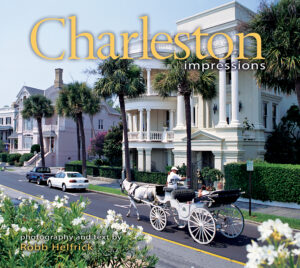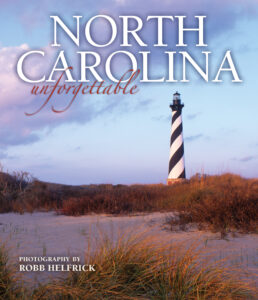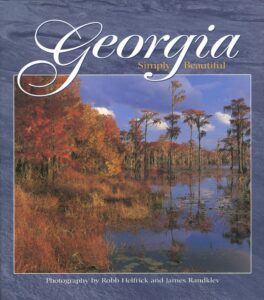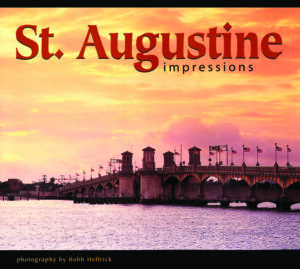Robb Helfrick Book Excerpts

From "Charleston Impressions"
“My first visit to Charleston fell on the one-hundredth anniversary of the great 1886 earthquake. As a newcomer on that humid August day, I was surprised a city on the Atlantic seaboard could suffer such a California-type calamity.
Thoughts of that catastrophic centennial soon passed as I explored the city’s gracious neighborhoods. That day, despite mid-summer heat, activity flourished on Charleston’s narrow lanes. The clip-clop of horse-drawn carriages sounded on cobblestone streets as they toured past elegant homes. At City Market, local artisans sat silently in warm sunshine as they wove their distinctive sweetgrass baskets. Out on the Cooper River, a parade of massive container ships sailed into Charleston’s port, and each vessel created its own cooling breeze, bringing salty air onshore. Later, as evening arrived, I enjoyed a peaceful harbor view with distant Fort Sumter barely visible on a hazy horizon.
Charleston’s sensory elements left me with a distinct first impression. Life in the queen city of South Carolina’s Lowcountry seemed slow and easy. Charleston appeared destined to faithfully honor its storied past by serving as a historic time capsule- since the city is arguably the most lovingly preserved community in the United States. From its 1670 founding, Charleston had survived a succession of hardships and disasters; but a century after the earthquake it appeared a thick history book away from any further trials.
The supporting evidence was apparent on every street. Classic architecture survived three hundred years of weather and war, and antebellum plantations still spread out under live oaks along the Ashley River. In addition, Charleston had already begun an artistic renaissance that would fortify its claim as the South’s cultural capital. But three years later, Charleston learned it wasn’t completely free from demons of its tumultuous past.
On September 21, 1989, Hurricane Hugo slammed ashore with 130-mph winds and a twenty-foot storm surge. The powerful Category-Five tempest devastated South Carolina’s coast and left seven billion dollar’s worth of damage in its wake. For Charleston’s citizens, who conquered adversity many times before, it was likely their most difficult hour. In Hugo’s aftermath, Charleston proved it was not finished making history. Brick by brick, the community was rebuilt and restored to its former splendor. That resilient spirit and legendary tenacity remains an integral piece of Charleston’s identity and announces with a proud voice that this city will never be an ancient artifact trapped in amber.”

From "North Carolina Unforgettable"
“From shallow shoals of the Outer Banks to the Appalachian’s ancient peaks, North Carolina offers an infinite varierty of experiences and sensations. With an understated grace, this state has held on to ageless traditions without sacrificing the promise and progress of its future. It is this balance between humankind and nature, between past and present, that makes North Carolina truly original.
Over hundreds of years, residents have come to cherish the beauty and relaxation found in the Tar Heel State. It’s easy to understand why this landscape evokes such strong emotions.
Long before modern society could conceive of a place called Carolina, powerful forces shaped this land. In the east, rising and falling sea levels, along with prevailing winds, tides, and hurricanes, helped create a unique ecosystem. A string of peninsulas and barrier islands, now known as the Outer Banks, formed along the coastline. This sandy strand covers almost the entire shore of North Carolina and separates Currituck, Albemarle, and Pamlico Sounds from the Atlantic Oceans. This dynamic and unforgiving territory is known not only for its ever-changing scenery, but also for the dangerous waters that threaten mariners and their vessels. Since these currents claimed their first recorded victims in 1585, more than 1,000 shipwrecks have been documented in this treacherous area, known famously as the ‘Graveyard of the Atlantic’.
Remnants of earlier seafaring times are still evident along the seashore. Navigation is much safer these days, but lighthouses from a bygone era- some still in operation to protect modern skippers- are sprinkled along the coast. The most famous of these, the candy-striped Cape Hatteras Lighthouse, was moved inland in 1999 to escape encroaching surf. This sentinel remains an iconic North Carolina landmark. Tough and resilient wild horses roam sheltered beaches, thought to be descendants brought to the new world by Spanish explorers. Massive sand dunes still found here once provided altitude and a steady wind for the Wright brothers first flight, and today give modern adventurers lift when hang-gliding at Jockey’s Ridge State Park.
Always, a hint of the untamed makes itself known here. Wildlife is abundant in this coastal sanctuary, often seen in the sky overhead, or burrowing into the ever-shifting sandy soil.”

From "Georgia Simply Beautiful"
“I arrived in Georgia lured by Atlanta’s promise, a prospering city far from my northern small-town roots. For my first few years I was a suburb dweller and knew little about natural and historic treasures that flourished in my adopted state.
My universe expanded when I took a trip to Savannah. The journey to Georgia’s birthplace was a welcome respite from fast-paced, big-business Atlanta. Savannah had verdant squares shaded by meandering forms of live oak trees that seemed to move when Spanish moss swayed in a sultry southern breeze. The pace of life was more to my liking, for it was easy to amble and slow down.
Savannah’s history and elegance were equally captivating. The city’s colorful past was filled with stories of wealthy cotton merchants who left behind a tradition of grand architecture- a legacy saved a hundred years later by a group of determined women who laid the groundwork for Savannah’s historic preservation. On that first visit, pink and white spring azaleas flaunted their color in every square, and flowering dogwoods framed doorways of stately residences. I was caught in a spell of Savannah’s mysterious beauty.”

From "St. Augustine Impressions"
“Henry Flagler was a wealthy man and a visionary. He made his fortune as a cofounder of Standard Oil Company along with partner John D. Rockefeller. Flagler fell in love with St. Augustine on his first visit, saw the town’s potential in tourism, and acted. He built two magnificent hotels, the Hotel Ponce de Leon and the Alcazar Hotel. He also purchased the recently constructed Hotel Casa Monica. These three properties, holding court on King Street, were the cornerstone of St. Augustine’s new hospitality identity. Flagler then bought surrounding rail lines and established the Florida East Coast Railroad. As a result, he possessed all the resources to entertain northern tourists. His empire would ultimately stretch to Key West at the southern tip of Florida.
Today, these three historic buildings still stand: superb examples of Flagler’s legacy. The Hotel Ponce de Leon has become Flagler College; with its lovely Spanish Renaissance style, it is St. Augustine’s architectural icon. The Alcazar Hotel is now the Lightner Musuem, which houses an impressive collection of Victorian treasures such as paintings, porcelain and furniture. The Casa Monica was renovated and still welcomes guests as a posh hotel. Henry Flagler also built a magnificent church in memory of his daughter. The Flagler Memorial Presbyterian Church, completed in 1889 in the Venetian Renaissance style, is the final resting place for Flagler and his family.
As St. Augustine’s reputation as a tourist destination grew, so did its collection of unique places of interest. The St. Augustine Lighthouse was completed in 1874 and serves as a luminous architectural reminder of mariners’ travel along the Atlantic. The famous Bridge of Lions, the city’s link to Anastasia Island and the beach, was constructed across the Matanzas River in 1927. On the western side of the bridge are two imposing lions, carved from Carrera marble, that guard the approach to downtown St. Augustine. These two lions gaze toward the Plaza de Constitution, the city’s landscaped promenade. A statue of Ponce de Leon towers over this green square filled with monuments and quiet pathways.
On the Plaza’s north side, the Cathedral Basilica of St. Augustine proudly presides beside the verdant square. Constructed in 1797, the church has survived the town’s hardships, but thrives today as a vital part of the religious community. The Cathedral, with its elegant stained-glass windows and soaring bell tower, is fittingly known as the ‘First Parrish’.
Away from downtown in a quieter setting, the Mission of Nombre de Dios sits on shaded grounds overlooking a salt marsh. Often called ‘God’s most sacred acre’, the Mission occupies holy ground. This is where Christianity began in the United States. The Mission shares its home with the Shrine of Our Lady of La Leche and the Great Cross, a 208-foot golden monument that is visible along the waterfront. The power and strength of St. Augustine’s religious traditions are evident throughout this old city.”
